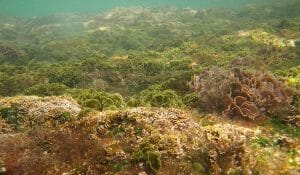Photoautotroph Definition
Photoautotrophs are organisms that can make their own energy using light and carbon dioxide via the process of photosynthesis. The word photoautotroph is a combination of autotroph, the word for an organism that makes its own food, and the prefix photo-, which means “light”. Green plants and photosynthetic bacteria are examples of photoautotrophs. They are not to be confused with photoheterotrophs, which also make energy from light but cannot use carbon dioxide as their sole source of carbon, and instead use organic materials.
Function of Photoautotrophs
Photoautotrophs essentially make their own food, which is how they can survive and reproduce. However, they are also important for the survival of heterotrophs, organisms that can’t make their food and must eat other organisms to survive. Heterotrophs eat autotrophs; for example, cattle eat grass, and then humans eat those cattle. Photoautotrophs and other autotrophs are at the bottom of the food chain; they provide food for other organisms and are vital in all ecosystems. They are known as producers in the food chain, since they produce nutrients that all other animals need to survive. Without them, humans along with other animals would not survive because they would not have food.
Photoautotrophs are also important because they take in carbon dioxide, a byproduct of respiration in heterotrophs. In addition, phototrophs give off oxygen as a result of photosynthesis, and animals need this oxygen in order to survive.
Types of Photoautotrophs
Green Plants
Nearly all plants are photoautotrophs, which a few exceptions like Indian Pipe (Monotropa uniflora). This category of green plants includes all of the different forms of plant life, such as trees, mosses, and grasses. Plants are important sources of food in terrestrial ecosystems. They can make their own energy from light because they produce the molecule chlorophyll in organelles called chloroplasts within their cells. Chlorophyll absorbs light and transfers its energy to parts of the plant that can use that energy. It also gives plants their green color. Indian Pipe has lost the ability to produce chlorophyll, which is why it cannot produce its own energy from light. Instead, it parasitizes certain species of trees and fungi and “steals” their nutrients.
Bacteria
Some bacteria are photoautotrophs; most of these are called cyanobacteria or blue-green bacteria (formerly called blue-green algae). Like plants, cyanobacteria also produce chlorophyll. In fact, cyanobacteria are responsible for the origin of plants. Millions of years ago, cyanobacteria were taken up into cells, where they were able to make food for those cells in return for a place to live. This means that the chloroplasts in plant cells are actually cyanobacteria. Since cyanobacteria reproduce asexually, these chloroplasts are copies of the cyanobacteria that entered plant cells long ago. Green sulfur bacteria are another type of photoautotrophic bacteria that are ecologically similar to cyanobacteria, but they use sulfide ions instead of water during photosynthesis, and do not produce oxygen.
Algae
Algae come in many forms; they can be single-celled or multicellular (seaweed is a type of algae). They are important producers in aquatic ecosystems, but they can also found in terrestrial ones. Not all algae evolved from the same common ancestor, and as a result, only some species of algae are photoautotrophs. Like other photoautotrophs, algae are important producers of oxygen. Algae produce about half of the oxygen in the atmosphere.
If too much algae flourishes in an algal bloom, this can disrupt the ecosystem by producing certain toxins and making nutrients less available. Algal blooms are often caused by human activities such as using nitrogen-containing fertilizers and improperly treating wastewater. However, algae are efficient users of carbon dioxide in the atmosphere and may also be able to be used as a source of biofuel in the future to replace fossil fuels.
This photograph depicts a variety of algae growing in shallow water.
Differences from Chemoautotrophs
Chemoautotrophs are another type of autotroph. Like photoautotrophs, they make their own food, but they use energy from chemical reactions instead of light energy to do so. This allows them to survive in places where there is no sunlight, such as the deep ocean floor. Some examples of chemoautotrophs are nitrogen-fixing bacteria and iron-oxidizing bacteria.
Related Biology Terms
- Autotroph – an organism that produces its own food.
- Heterotroph – an organism that cannot produce its own food and must rely on consuming other organisms to survive.
- Photoheterotroph – an organism that makes energy from light but uses organic materials for its carbon source instead of inorganic carbon dioxide, which is used by photoautotrophs.
- Photosynthesis – the process by which photoautotrophs absorb light and convert its energy into chemical energy to power their cells.
Test Your Knowledge
1. Which organisms are NOT photoautotrophs?
A. Algae
B. Cyanobacteria
C. Humans
D. Apple trees
2. What molecule is responsible for absorbing light in the cells of photoautotrophs?
A. Oxygen
B. Hemoglobin
C. Chlorophyll
D. Sodium chloride
3. What cell organelle carries out photosynthesis?
A. Endoplasmic reticulum
B. Ribosome
C. Mitochondrion
D. Chloroplast
Photoautotroph

No comments:
Post a Comment